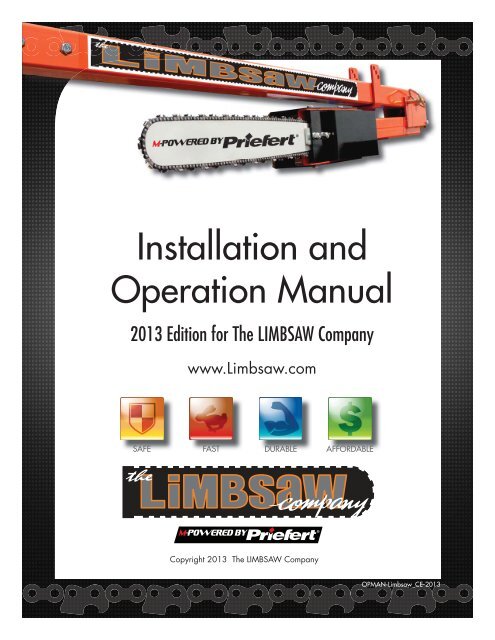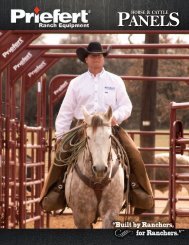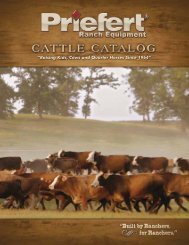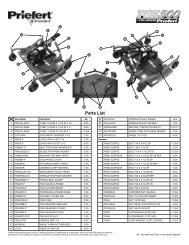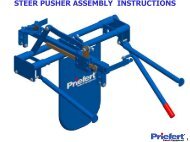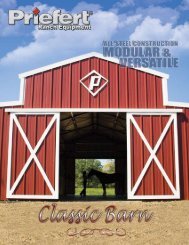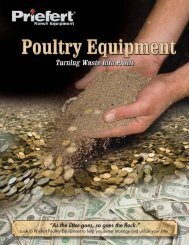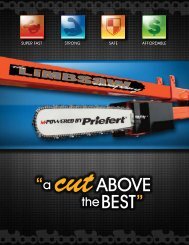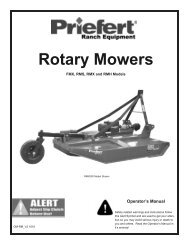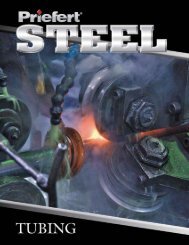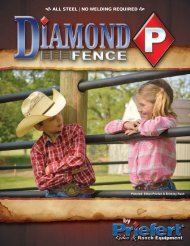Limbinator Operation - Priefert Manufacturing
Limbinator Operation - Priefert Manufacturing
Limbinator Operation - Priefert Manufacturing
- No tags were found...
You also want an ePaper? Increase the reach of your titles
YUMPU automatically turns print PDFs into web optimized ePapers that Google loves.
Installation and<br />
<strong>Operation</strong> Manual<br />
2013 Edition for The LIMBSAW Company<br />
www.Limbsaw.com<br />
SAFE FAST DURABLE AFFORDABLE<br />
Copyright 2013 The LIMBSAW Company<br />
OPMAN-Limbsaw_CE-2013
CUSTOMER PREPARATION CHECKLIST<br />
□<br />
□<br />
□<br />
□<br />
□<br />
□<br />
Verify packaging for all contents.<br />
Follow assembly and installation carefully, do not proceed if you have any questions.<br />
Contact The LIMBSAW Company with any questions you have regarding assembly or installation.<br />
Ensure that any and all fasteners are secured.<br />
Operators have read all Safety & <strong>Operation</strong> sections of this manual and understand the safe and proper<br />
use of the equipment.<br />
I understand that unauthorized alteration voids the warranty.<br />
Model Number:<br />
Serial Number:<br />
______________________________________________<br />
______________________________________________<br />
Do not remove this checklist from the Operator’s Manual.<br />
It is the responsibility of the owner to complete the procedures listed above.<br />
WARNING<br />
OSHA, ASABE, SAE and ANSI standards require the use of protective guards at all times for non-agricultural use. The LIMBSAW<br />
Company strongly recommends that such guards should be used to minimize risk of property damage, serious bodily injury or<br />
even death from object hazards or by contacting rotating parts, i.e. driveline, tires, etc.<br />
OSHA STD 1928.57: GUARDING OF FARM FIELD EQUIPMENT. CSA Z432-04 (R2009): SAFEGUARDING OF MACHINERY.<br />
BS EN 953:1997+A1:2009: SAFETY OF MACHINERY; GUARDS. General requirements for the design and construction of fixed and<br />
movable guards<br />
European Union Statement of Compliance<br />
The CE mark is affixed to the Limb Saw product to confirm compliance with the following European Community Standards<br />
and Directives:<br />
BS EN ISO 12100: SAFETY OF MACHINERY - GENERAL PRINCIPLES FOR DESIGN – 2010 ; RISK ASSESSMENT AND RISK REDUCTION .<br />
This equipment conforms with the protection requirements of Council Directives 2006/42/EC on the approximation of the<br />
laws of the Member States relating to Safety of machinery.<br />
2
Installation & <strong>Operation</strong> Manual<br />
Table of Contents<br />
Customer Preparation Checklist . . . . . . . . . . . . . . . . . . . . . . . . . . . . . . . . . . . . . . . . . . . . . . . . . . . 2<br />
Welcome . . . . . . . . . . . . . . . . . . . . . . . . . . . . . . . . . . . . . . . . . . . . . . . . . . . . . . . . . . . . . . . . . . 4<br />
Using This Manual . . . . . . . . . . . . . . . . . . . . . . . . . . . . . . . . . . . . . . . . . . . . . . . . . . . . . . . . . . . . 4<br />
Owner Assistance . . . . . . . . . . . . . . . . . . . . . . . . . . . . . . . . . . . . . . . . . . . . . . . . . . . . . . . . . . . . . . . . 4<br />
Customer Service . . . . . . . . . . . . . . . . . . . . . . . . . . . . . . . . . . . . . . . . . . . . . . . . . . . . . . . . . . . . . . . . . 4<br />
Safety . . . . . . . . . . . . . . . . . . . . . . . . . . . . . . . . . . . . . . . . . . . . . . . . . . . . . . . . . . . . . . . . . . . . 5<br />
Safety Alert Symbols. . . . . . . . . . . . . . . . . . . . . . . . . . . . . . . . . . . . . . . . . . . . . . . . . . . . . . . . . . . . . . . 5<br />
Signal Words. . . . . . . . . . . . . . . . . . . . . . . . . . . . . . . . . . . . . . . . . . . . . . . . . . . . . . . . . . . . . . . . . . . . 5<br />
High Pressure Fluids Hazard . . . . . . . . . . . . . . . . . . . . . . . . . . . . . . . . . . . . . . . . . . . . . . . . . . . . . . . . . 7<br />
Chain Saw Safety . . . . . . . . . . . . . . . . . . . . . . . . . . . . . . . . . . . . . . . . . . . . . . . . . . . . . . . . . . . . . . . . 7<br />
Safety Labels . . . . . . . . . . . . . . . . . . . . . . . . . . . . . . . . . . . . . . . . . . . . . . . . . . . . . . . . . . . . . . . . . . . . 8<br />
Shipped Container Contents . . . . . . . . . . . . . . . . . . . . . . . . . . . . . . . . . . . . . . . . . . . . . . . . . . . . . 9<br />
Assembling The Saw . . . . . . . . . . . . . . . . . . . . . . . . . . . . . . . . . . . . . . . . . . . . . . . . . . . . . . . . . . 9<br />
Installing The Receiver . . . . . . . . . . . . . . . . . . . . . . . . . . . . . . . . . . . . . . . . . . . . . . . . . . . . . . . . . 10<br />
Mounting The Saw . . . . . . . . . . . . . . . . . . . . . . . . . . . . . . . . . . . . . . . . . . . . . . . . . . . . . . . . . . . . 10<br />
<strong>Operation</strong>al Guidelines . . . . . . . . . . . . . . . . . . . . . . . . . . . . . . . . . . . . . . . . . . . . . . . . . . . . . . . . 11<br />
Operating Position . . . . . . . . . . . . . . . . . . . . . . . . . . . . . . . . . . . . . . . . . . . . . . . . . . . . . . . . . . . . 11<br />
Chain Tensioning . . . . . . . . . . . . . . . . . . . . . . . . . . . . . . . . . . . . . . . . . . . . . . . . . . . . . . . . . . . . . 11<br />
Chain Tensioning Procedure. . . . . . . . . . . . . . . . . . . . . . . . . . . . . . . . . . . . . . . . . . . . . . . . . . . . . . . . . 12<br />
Automatic Chain Oiling System . . . . . . . . . . . . . . . . . . . . . . . . . . . . . . . . . . . . . . . . . . . . . . . . . . . 12<br />
Initial <strong>Operation</strong>. . . . . . . . . . . . . . . . . . . . . . . . . . . . . . . . . . . . . . . . . . . . . . . . . . . . . . . . . . . . . . . . . 12<br />
Using Your LIMBSAW . . . . . . . . . . . . . . . . . . . . . . . . . . . . . . . . . . . . . . . . . . . . . . . . . . . . . . . . . . 13<br />
Removal of LIMBSAW during Transportation . . . . . . . . . . . . . . . . . . . . . . . . . . . . . . . . . . . . . . . . . . . . . 13<br />
Replacement Parts . . . . . . . . . . . . . . . . . . . . . . . . . . . . . . . . . . . . . . . . . . . . . . . . . . . . . . . . . . . . 14<br />
Warranty Information . . . . . . . . . . . . . . . . . . . . . . . . . . . . . . . . . . . . . . . . . . . . . . . . . . . . . . . . . . 15<br />
References . . . . . . . . . . . . . . . . . . . . . . . . . . . . . . . . . . . . . . . . . . . . . . . . . . . . . . . . . . . . . . . . . 16<br />
This manual contains the recommended installation instructions and operational safety guidelines. Please completely<br />
familiarize yourself with these instructions and safety guidelines to minimize chances of injury and to increase<br />
professional results regarding your LIMBSAW and its use.<br />
WARNING:<br />
If you do not understand any part of the instructions and precautions in this manual, please contact your<br />
local LIMBSAW dealer or representative, CONTACT US thru the www.Limbsaw.com website,<br />
or call 1-580-272-3194 BEFORE beginning installation or operation.
WELCOME<br />
LIMBSAW was invented by Wendell McCracken of Pauls Valley, Oklahoma.<br />
A retiree with a Master’s degree in Electrical Engineering, Wendell and his<br />
wife Donna raised eight children on their 250 acre pecan and cattle farm<br />
where tree trimming was an ongoing family chore.<br />
Having invented and patented items his whole life, Wendell came up with<br />
the LIMBSAW after his children moved away and left pruning to him and<br />
his wife. Far from his first invention, Wendell has worked on radar systems<br />
for the B-52 Hustler project and several other patents relating to phone<br />
systems and ”down hole” measuring devices. He has even worked on<br />
armored bullet-proof cars and, most recently, built his own airplane.<br />
Your LIMBSAW has been designed with care and built by skilled workers<br />
using quality materials. Proper maintenance and safe operating practices<br />
outlined in this manual will help you get years of superb use and excellent<br />
results from the LIMBSAW.<br />
REMEMBER SAFETY FIRST!<br />
Be Alert - Eliminate unsafe habits and risky behavior,<br />
recognize hazards as they exist and read and follow<br />
the Operator’s Manual for your LIMBSAW and your tractor!<br />
Application<br />
Using hand-held chainsaws, bow saws, or pole saws while standing in the<br />
bucket of a tractor or on a ladder can be an accident waiting to happen.<br />
The LIMBSAW drastically reduces the risk of injury by eliminating these<br />
common practices. Limbs fall in front of the loader while you sit in the<br />
safety of your tractor seat. In addition, the danger of chainsaw kickback<br />
is virtually eliminated. And, the ability to reverse the motor can provide<br />
needed help to back the saw out in case of a pinch.<br />
• Mounts directly to front-end loader of your tractor, skid-loader or<br />
backhoe and is easily attached by one person.<br />
• Quieter, safer and easier to use than a hand-held chainsaw.<br />
• Reversible motor helps back the saw out of a pinch.<br />
• Equipped with a self-oiling system.<br />
• Easy-access, built-in chain tensioning system.<br />
• Trims limbs up to 8’ higher than your loader can reach.<br />
USING THIS MANUAL<br />
This <strong>Operation</strong> Manual is designed to help familiarize you with<br />
safety, operation and adjustments. Read this manual and follow the<br />
recommendations to help ensure safe and efficient operation.<br />
The information contained within this manual was current at the time of<br />
printing. Your model may vary in design and configuration from those<br />
shown in this manual.<br />
Some parts may change slightly to assure you of the best performance.<br />
To order a new Manual or Parts contact The LIMBSAW Company.<br />
Your LIMBSAW has an instructional video available online as well as this<br />
<strong>Operation</strong> Manual in PDF format. Both have been designed to assist you<br />
in achieving optimal results with your LIMBSAW.<br />
The <strong>Operation</strong> Manual is a compilation of engineering data and field<br />
experience, and contains general information for adjustments and<br />
operation as every situation varies to usage, and location specifics; with<br />
experience using the LIMBSAW and this manual, you should be able to find<br />
the right procedures that is perfectly suitable to your needs.<br />
Terminology<br />
“Right” or “Left” as used in this manual is determined by facing forward<br />
in the direction the machine will operate while in use unless otherwise<br />
stated.<br />
Owner Assistance<br />
If customer service, parts or repair is required, contact The LIMBSAW<br />
Company to reach our trained personnel who will assist you with repair<br />
parts and equipment needed to service your LIMBSAW. The parts on your<br />
LIMBSAW have been specifically designed and should only be replaced<br />
with genuine LIMBSAW parts. Therefore, should your LIMBSAW require<br />
replacement parts contact our support personnel.<br />
Customer Service<br />
The LIMBSAW Company wants you to be satisfied with your new LIMBSAW.<br />
If for any reason you do not understand any part of this manual or are not<br />
satisfied with the service required, the following actions are suggested:<br />
Contact our Customer Service Department. We will respond within 24 hours;<br />
usually much more quickly. You may contact our Customer Service by calling<br />
1-580-272-3194 during our normal business hours (Monday thru Friday<br />
8am to 5pm CST). After hours or weekend support, simply leave a voice<br />
message for a specialist. He or she will be automatically notified to call you<br />
back promptly.<br />
For further assistance: contact us via the web:<br />
http://www.limbsaw.com/<br />
Or you may contact us in writing at:<br />
The LIMBSAW Company<br />
46235 E. County Road 1510<br />
Stratford, OK 74872<br />
4
SAFETY<br />
Safety Alert Symbols<br />
The SAFETY ALERT SYMBOL indicates there is a potential<br />
hazard to personal safety involved and extra safety precaution<br />
must be taken. When you see this symbol, be alert and carefully read<br />
the message that follows it. In addition to design and configuration of<br />
equipment, hazard control and accident prevention are dependent upon the<br />
awareness, concern, prudence and proper training of personnel involved in<br />
the operation, transport, maintenance and storage of equipment.<br />
Owner/operator can prevent and is responsible for accidents or injuries<br />
occurring to other people, themselves, and/or property and equipment.<br />
Thoroughly read and understand the operator’s manual, references and<br />
other material supplied with the LIMBSAW and tractor. If the operator<br />
cannot read English, it is the owner’s responsibility to explain this material to<br />
them. This publication is available as a special request in other languages.<br />
Refer to the “Safety Label” section, read all instructions noted on them.<br />
We strongly recommend that children are not allowed to operate machinery.<br />
Do not allow untrained people to operate or service equipment.<br />
Operator Safety<br />
• Operator must be familiar with these instructions and functions of the<br />
LIMBSAW and tractor before use.<br />
• Operate only with tractor, skid-loader or backhoe equipped with ROPS<br />
and seat belts.<br />
• Operate implement from the Driver’s seat only.<br />
• Disengage the hydraulic pump, stop the engine and be sure all<br />
equipment is stopped before dismounting from tractor. Dismounting<br />
from a moving tractor could cause serious injury or death.<br />
Machinery Safety<br />
• Do not leave tractor and/or LIMBSAW unattended while<br />
it is running.<br />
• Inspect both the tractor and the LIMBSAW before you operate. Be<br />
sure hardware is tight. Repair or replace damaged, badly worn, or<br />
missing parts.<br />
• Be sure guards and shields are in good condition and secured before<br />
operating the implement. Make any necessary adjustments before<br />
operation.<br />
• Do not allow anyone to stand in front of the tractor or under the<br />
implement during operation.<br />
• Make sure all persons are clear of the working area. Stop machine<br />
if anyone enters the area. Never carry passengers and keep pets,<br />
livestock and bystanders away.<br />
• Inspect the area where the equipment is to be used and remove all<br />
objects prior to operating the LIMBSAW and tractor.<br />
• Disengage hydraulic pump, fold and secure boom during travel,<br />
remove from vehicle when transporting vehicle or not in use.<br />
• Only operate during daylight or with good artificial light.<br />
DANGER:<br />
AVOID OPERATING EQUIPMENT NEAR OVERHEAD<br />
POWER LINES! The required minimum safe distances (clearance) from<br />
overhead power lines is 10 ft. Contact with electrical connections could<br />
result in injury or death and equipment damage. Never touch downed<br />
power lines.<br />
• Watch out for wires and other obstacles when raising implement.<br />
Have a qualified electrician de-energize powerlines within your work<br />
area prior to operation. Contact with electrical connections could result<br />
in injury or death and equipment damage.<br />
WARNING:<br />
AVOID INJURY FROM FALLING OBJECTS! Recognize the<br />
hazards associated with working near overhead obstructions. Your<br />
vehicle should be fi tted with an overhead guard to offer protection from<br />
the impact of falling limbs and branches.<br />
• Slow down and use care when approaching blind corners or other<br />
objects that obscure vision. Remember that the LIMBSAW extends<br />
beyond the front of the loader and requires additional clearance in front<br />
of the loader. Do not turn sharply. Use additional CAUTION when turning<br />
or operating under adverse surface conditions.<br />
• Use care when reversing. Look behind and down before backing up to<br />
be sure of a clear path.<br />
• If you hit an unexpected object or if abnormal vibration occurs, stop<br />
the machine and inspect it. Make repairs before resuming operation<br />
of equipment. Keep LIMBSAW properly maintained and in good<br />
working order.<br />
Practice Safe Maintenance<br />
Understand procedures before starting any work. Use proper tools, and<br />
equipment, refer to this <strong>Operation</strong> Manual for additional information.<br />
• Work in a clean dry level area.<br />
• Check all fluid levels on the tractor before operation.<br />
• If you need to refill fuel or oils wait approximately one hour for these<br />
fluids to cool.<br />
• Lower the implement to the ground, put the tractor into park, turn off<br />
engine and remove key before performing any maintenance.<br />
• Allow implement to cool completely.<br />
• Even with the engine turned off, hydraulic systems and mechanical<br />
systems can fail or movement of levers can cause equipment to drop<br />
unexpectedly causing severe injury or death.<br />
• Do not grease or oil implement while it is in operation.<br />
• Inspect all parts. Make sure parts are in good condition and installed<br />
properly.<br />
• Remove build-up of grease, oil or debris.<br />
• Remove all tools and unused parts from implement before operation.<br />
• Never tamper with safety devices. Check their proper operation<br />
regularly.<br />
BE AWARE OF SIGNAL WORDS: A signal word designates a degree of level of hazard seriousness.<br />
NOTE: Provides helpful information to the operator.<br />
IMPORTANT:<br />
equipment.<br />
Indicates failure to observe may cause damage to<br />
WARNING: Indicates a potentially hazardous situation which, if not<br />
avoided, could result in death or serious injury, and includes hazards<br />
that are exposed when guards are removed. It may also be used to alert<br />
against unsafe practices. 1<br />
CAUTION: Indicates an imminently hazardous situation, which, if not<br />
avoided, may result in minor or moderate injury. It may also be used to<br />
alert against unsafe practices. 1<br />
DANGER: Indicates an imminently hazardous situation, which, if not<br />
avoided, will result in death or serious injury. This signal word is limited<br />
to the most extreme situations, typically for machine components that, for<br />
functional purposes cannot be guarded. 1<br />
1. Sentry Insurance, FEMA, Owner’s and Operators Manuals for Farm Equipment, Sentry Insurance, Stevens Point, WI, revised Management Bulletin No. 112, 90-42;<br />
March 2007, pp S-2.<br />
5
SAFETY<br />
Emergency Preparedness<br />
• Keep a fire extinguisher on your tractor and check the<br />
expiration date periodically!<br />
• Keep a well stocked first aid kit on your tractor.<br />
• Save In Case of Emergency ( I.C.E ) numbers on your cell phone<br />
(including doctors, hospital and 911 services).<br />
• Keep I.C.E. numbers next to a home or office phone.<br />
Keep Riders off Machinery<br />
• Only allow the operator on the machine. Keep riders off!<br />
• Riders may obstruct the operator’s view resulting in the tractor being<br />
operated in an unsafe manner.<br />
• Riders on the tractor or LIMBSAW may be struck by foreign objects or<br />
thrown off the machine causing serious injury.<br />
• Never allow children to operate equipment.<br />
Wear Protective Equipment<br />
• Protective clothing and equipment should be worn.<br />
• Wear clothing and equipment appropriate for the job.<br />
Avoid loose fitting clothing to avoid entanglement with moving parts.<br />
• Keep hands, feet, clothing, and long hair or anything worn that can be<br />
caught away from power-driven parts.<br />
• Prolonged exposure to loud noise can cause hearing impairment or<br />
hearing loss. Wear suitable hearing protection such as earmuffs or<br />
earplugs.<br />
• Operating equipment requires the full attention of the operator.<br />
• Avoid wearing radio headphones, MP3 players or using cell phones<br />
while operating equipment.<br />
Transporting & Towing Loads Safely<br />
• Comply with state and local laws.<br />
• Maximum Travel speed for implement is 20 mph. DO NOT EXCEED!<br />
• Never travel at a speed which does not allow adequate control of<br />
steering and stopping.<br />
• Sudden braking can cause a towed load to swerve and upset.<br />
• Reduce speed if towed load is not equipped with brakes.<br />
• IMPORTANT! Do not tow any load that is more than double the weight<br />
of the tractor.<br />
• Stopping distance increases with speed and weight of the towed load.<br />
Travel slowly and allow extra time and distance to stop.<br />
• Transport only with clean reflectors, SMV signage and working lights.<br />
• Ensure that the implement components are in “up” or “Travel” position<br />
before moving. Always remove LIMBSAW from vehicle before transport.<br />
• Lower the implement to “field position” when ready to use. This keeps<br />
the load pulling below the center of gravity.<br />
Avoid Tipping<br />
• Danger of tipping is increased greatly with tires are set in<br />
narrow tread setting and driving at a high rate of speed.<br />
• LIMBSAW weight (based on model) plus 2505 pounds<br />
of water weight (8.35 x 300 gallons) must not exceed combined<br />
weight of tractor and operator. If the LIMBSAW + water<br />
exceeds this weight then refer to the tractor’s manufacturer’s<br />
recommendations for wheel weights or counterweights for added<br />
stability when operating with LIMBSAW.<br />
6<br />
Use Caution Around Hydraulic Systems<br />
• Worn, lose or malfunctioning hydraulic hoses can cause<br />
highly pressurized oil to escape, potentially causing great<br />
harm to humans or equipment. Search for leaks with a piece of<br />
cardboard. Protect hands and body from high pressure fl uids.<br />
• Keep Hydraulic hoses out of direct sunlight and in a controlled climate<br />
during storage periods to prevent deterioration and increase hose life.<br />
• Avoid High-Pressure Fluids. Escaping fluid under pressure can penetrate<br />
the skin causing serious injury. Avoid the hazard by relieving pressure<br />
before disconnecting hydraulic or other lines. Tighten all connections<br />
before applying pressure.<br />
Use Safety Lights and Devices<br />
• Slow moving tractors, self-propelled equipment, and towed<br />
implements can create a hazard when driven on public<br />
roads. They are difficult to see, especially at night.<br />
• Flashing WARNING lights and turn signals are recommended.<br />
• Use lights and devices provided with the machinery.<br />
Tire & Wheel Safety<br />
• Read and understand any manufacturer’s warning contained in literature<br />
or molded into the tire sidewall before servicing tires.<br />
• Only use specialized tools as recommended by tire<br />
suppliers for mounting or dismounting tires.<br />
• Explosive separation of a tire and rim parts can<br />
cause serious injury or death.<br />
• Do not attempt to remove a tire from the rim without<br />
removing air pressure as this may cause serious<br />
injury or death.<br />
• Check tires for low pressure, bulges (bubbles), cuts, damaged rims or<br />
missing lug bolts and nuts.<br />
• Do not re-inflate a tire that has been operated in a run-flat or under<br />
inflated condition (80% or less than recommended pressure).<br />
Demount and inspect tire and rim parts before re-inflating.<br />
Periodically, inspect the equipment’s tires:<br />
• Inspect inside of tire for loose cords, cuts, penetrating objects or other<br />
casing damage.<br />
• Inspect valve cores. Replace valve cores if damaged or leaking.<br />
• Lubricate with only approved tire mounting lubricant or mild vegetable<br />
oil soap solution. Do not use anti-freeze, silicones or petroleum base<br />
lubricants as these will damage tires.<br />
• Un-repairable tires should be destroyed and replaced with tire having<br />
the same rim diameter designation and suffix letters.<br />
• Do not mount or use damaged tires or rims.<br />
• Check wheel hardware for tightness. Loose wheel nuts may cause<br />
instability resulting in an accident that may result in serious injury.<br />
Perform this check often during the first 100 hours of operation.<br />
• Do not attempt to mount a tire without proper equipment or experience<br />
in performing this operation.<br />
• Always maintain proper tire pressure. Do not over inflate above the<br />
recommended pressure. Low pressure may cause loss of control during<br />
operation while on slopes or wet/slick surfaces.
SAFETY<br />
Tire & Wheel Safety (cont.)<br />
• Never attempt to weld or heat a wheel and tire assembly. Heat<br />
increases air pressure resulting in tire explosion causing serious injury<br />
or death. Welding can impair the structural integrity by weakening or<br />
deforming the wheel.<br />
• To safely inflate tires use a clip-on chuck and extension hose long<br />
enough to allow you to stand to one side. DO NOT STAND or SIT IN<br />
FRONT OF or OVER the tire assembly.<br />
• Never use a tire as a step as the tire may roll and cause serious injury.<br />
• Most agricultural tire, wheel, hub and spindles have a maximum speed<br />
of 25 mph.<br />
Avoid High Pressure Fluids Hazard<br />
It is impossible to overemphasize the importance of implementing<br />
and adhering to safe practices when working with pressurized<br />
fluids, and components in hydraulic & pneumatic systems. A fluid<br />
system failure can result in equipment damage, production loses,<br />
personal injury, or even death.<br />
CAUTION:<br />
Avoid injury! Escaping fluid under high pressure<br />
can penetrate the skin and cause serious injury. A pinhole<br />
leak in any portion of the hydraulic system while pressurized<br />
can puncture clothing such as gloves, coveralls and penetrate<br />
skin from a distance of as much as four inches.<br />
Avoid the hazard by relieving the pressure before connecting hydraulic or<br />
other lines otherwise the connectors will not lock safely.<br />
Wear protective equipment such as gloves, long sleeves and safety glasses<br />
or goggles.<br />
The LIMBSAW Company highly recommends that a skilled mechanic familiar<br />
with hydraulic safety should check hydraulic hoses for leaks while pressurized<br />
when leaks cannot be detected while not under pressure.<br />
Run a piece of cardboard along the hose – NOT BODY PARTS! If the hydraulics<br />
need to be activated for any reason during the work, the mechanic should<br />
step back a safe distance, then signal the operator to start the machine.<br />
Major areas for maintaining safe conditions and efficient operations with<br />
regard to fluid systems:<br />
• Inspecting hoses and components before starting machinery and<br />
draining pressure from the hydraulic lines before inspecting them<br />
for leaks. Most hydraulic leaks can be detected without the need to<br />
pressurize the lines. Even if the machine has been shut off, operators<br />
need to ensure that the pressure has been relieved from the hoses.<br />
• Replace worn hoses, any connectors or components with the<br />
recommended manufacturer’s replacement parts that meet required<br />
specifications for safe operation.<br />
• Tighten all connectors before applying pressure. Follow proper hose<br />
assembly and routing guidelines to prevent premature failures and<br />
promote hose safety.<br />
• Keep Hydraulic hoses out of direct sunlight and in a controlled climate<br />
during storage periods to prevent deterioration and increase hose life.<br />
If an accident occurs seek immediate medical treatment!<br />
Any fluid injected into the skin must be surgically removed<br />
within a few hours or gangrene may result. If your Doctor is<br />
unfamiliar with this type of injury, reference a knowledgeable<br />
medical source.<br />
Your Tractor, Skidloader, Backhoe (vehicle)<br />
• It is important that you completely understand and follow all safety<br />
precautions listed in your tractor, skidloader, backhoe or other vehicle<br />
manual. Check with your LIMBSAW dealer to be sure that the LIMBSAW<br />
will be compatible with your vehicle. Your ability to drive and maneuver<br />
this vehicle and its front end loader in a safe, familiar, and professional<br />
manner is directly related to your safety and the professional results you<br />
will obtain with your saw.<br />
• Cuts are made by lowering the loader and/or rotating the bucket in<br />
a skilled manner. Uneducated driving of your vehicle and use of its<br />
loader may cause serious or fatal injury to the operator and bystanders,<br />
damage your LIMBSAW beyond immediate, simple repairs, or damage<br />
your vehicle.<br />
• Placing too much down pressure on the branch while<br />
you are making a cut could result in damage to the saw.<br />
Remember, the mechanics and the weight of your saw are<br />
what make the cut.<br />
• Re-read and familiarize yourself with all of the safety and operation<br />
instructions in your vehicle manual before installing and operating the<br />
LIMBSAW on your loader.<br />
IMPORTANT:<br />
Read the entire LIMBSAW Installation and <strong>Operation</strong> Manual<br />
and review the information on the limbsaw.com website before installing<br />
and operating your unit. Also re-read both your vehicle manual and your<br />
LIMBSAW Installation and <strong>Operation</strong> Manual at the beginning of each<br />
season to maintain your knowledge of this equipment. Periodically check the<br />
website of both your vehicle manufacturer and LIMBSAW for recent updates,<br />
engineering changes, improvements on equipment, and new videos. Parts<br />
and their usage, and the operation of your equipment may change over time.<br />
Serious or fatal injury can occur without maintaining proper familiarity with<br />
all your equipment.<br />
The Operator<br />
To minimize the chance of injury the operator of this cutting device must<br />
be physically capable, mentally aware and not under the influence of any<br />
mind influencing substance (drugs, alcohol, etc.) which could alter operator’s<br />
vision, dexterity or judgment, this includes the influence of fatigue.<br />
• Do not operate your vehicle or saw if you are tired. Operators that are<br />
tired or fatigued should immediately discontinue the use of this unit.<br />
Lack of concentration due to fatigue may cause loss of control of device<br />
leading to possible injury to operator and damage to equipment.<br />
• If you think you have any condition that might impair your physical or<br />
mental ability to operate this machine please check with your doctor<br />
before beginning use.<br />
Chain Saw Safety<br />
• Look for nails, spikes or other metal in the tree before cutting.<br />
• Disengage the saw when Traveling on rough or uneven terrain.<br />
• Proper personal protective equipment must be worn when operating<br />
the saw, which includes hand, foot, leg, eye, face, hearing and head<br />
protection.<br />
• Do not wear loose-fitting clothing.<br />
• Be careful that the trunk or tree limbs will not bind against the saw.<br />
• Watch for branches under tension, they may spring out when cut.<br />
• Potential injuries can be minimized by using proper personal protective<br />
equipment and safe operating procedures.<br />
7
SAFETY<br />
Safety Labels<br />
Your LIMBSAW comes equipped with all safety labels in place. They were<br />
designed to help you safely operate your implement.<br />
Read and follow their directions:<br />
• Keep all safety labels clean and legible.<br />
• Replace all worn, damaged or missing labels. To order new labels<br />
contact customer service.<br />
• Some new equipment installed during repairs may require new safety<br />
labels to be affixed to the replacement component. When ordering<br />
new components make sure the correct safety labels are in included in<br />
the request.<br />
To install new labels:<br />
a) Spray water on the surface where the label is to be placed<br />
and wipe dry.<br />
b) Peel backing from the label.<br />
c) Press firmly onto the surface.<br />
d) Squeeze out air bubbles with the edge of a credit card.<br />
Standard Safety Labels:<br />
WARNING - Hydraulic Fluid - High Pressure Hazard<br />
DANGER - Falling Limbs & Blade Cutting Hazards<br />
WARNING - Read Manual Before <strong>Operation</strong><br />
8<br />
Handling Waste Product and Chemicals<br />
• Waste products, such as used transmission oil, fuel, coolants, etc. can harm the environment or people.<br />
• Do not use beverage containers for waste fluids – someone may drink from them!<br />
• Contact your local Recycling Center to learn how to recycle or dispose of waste products. Material Safety Data Sheet (MSDS) provides specific details on the<br />
chemicals, physical and health hazards, safety procedures for using the chemical and emergency response techniques. The retailer of the chemical products used<br />
with your machine is responsible for providing the MSDS for that product.
YOUR SHIPPED CONTAINER SHOULD INCLUDE<br />
• a receiver pinned to the end of the 4' Boom Arm Bottom<br />
• a folded mast section with chainsaw and hydraulic lines<br />
The packet contains:<br />
• 4 nuts and bolts, for attaching the receiver to<br />
your loader<br />
• a 3/16" allen wrench for adjusting chain oiler<br />
• a brochure<br />
Strap Bracket<br />
• a warranty registration card<br />
• THIS Installation & <strong>Operation</strong> Manual, that<br />
you should read completely before you begin<br />
installation and operation<br />
Receiver<br />
Exit Flange<br />
ASSEMBLING THE SAW<br />
Hydraulic Hose Clamp<br />
The Boom sections must be joined before mounting LIMBSAW to your vehicle.<br />
Remove the two (2) bolts from the end of the LIMBSAW Arm assembly with a 9/16" wrench. Rotate<br />
and stand the Arm assembly onto the strap bracket, with hydraulic hoses toward you, as shown.<br />
Place Boom Arm Bottom at the end of the Arm assembly, hose exit flange toward you.<br />
Insert hydraulic hoses into swedge end of Boom Arm Bottom and out<br />
through exit fl ange. See pictures left and below. Slide sections together<br />
while pulling the slack from the hydraulic hoses.<br />
Exit Flange<br />
Remove bolts<br />
before assembly<br />
Reinsert the two (2) bolts and tighten with<br />
9/16" wrench to secure.<br />
Use a ½" wrench to loosen the hydraulic<br />
hose clamp, insert hoses, then retighten.<br />
9
INSTALLING THE RECEIVER<br />
Install the receiver to the back of your loader, at the top, on<br />
the right side.<br />
Positioning it at the top of the bucket, as shown in this<br />
picture, will afford you an extra two feet of reach when<br />
operating your saw.<br />
When installing the receiver with the bolts, use a ½"<br />
drill bit. Receiver can also be welded in place. Loaders<br />
which have rolled or folded lips may require a spacer<br />
to achieve proper alignment. Check alignment before<br />
proceeding with installation.<br />
Welded on<br />
Spacer<br />
Bolted on<br />
MOUNTING THE SAW<br />
Before mounting the LIMBSAW into the receiver, rotate your bucket<br />
so the receiver is positioned as shown. Your saw weighs about<br />
86 lbs, making it easy to mount. Lift the saw and insert the end<br />
into the receiver until it hits the stop. Pin and clip to secure.<br />
The saw can be easily removed and stored when not in use.<br />
Because every tractor has<br />
its hydraulic hookups in<br />
a different location, your<br />
LIMBSAW does not include<br />
the hydraulic lines that attach to the vehicle. You will need to<br />
purchase these lines with a minimum of ⅜" hydraulic hose.<br />
Measure from the auxiliary hookups of your vehicle to the<br />
hydraulic hookups on your saw. Allow enough slack in your lines<br />
for the full rotation of your<br />
bucket.<br />
The bottom right picture shows the saw in the Travel position.<br />
When driving to and from your work site, always keep the saw<br />
folded and pinned to protect it from the wear and tear that<br />
bouncing can cause. Always be aware of power lines and other<br />
hazards that may be hanging in your path.<br />
Travel Position<br />
10
OPERATIONAL GUIDELINES<br />
CAUTION:<br />
Thoroughly read and understand the operation manual, references and other material supplied with the LIMBSAW and tractor prior to<br />
operating this equipment. Failure to do so can cause injury or death.<br />
CAUTION:<br />
Never drive your vehicle while the chain saw is in the open<br />
position or is spinning. Always disengage the hydraulics, and fold the<br />
saw into the Travel position. Driving your vehicle with the chainsaw<br />
in the open position can result in bending the mast and pins. Always<br />
operate your LIMBSAW from the safety of your vehicle seat. Always<br />
turn off your vehicle engine, fold and pin your LIMBSAW into the<br />
Travel position, before parking your vehicle for the day. Remove<br />
LIMBSAW from vehicle when transporting the vehicle.<br />
DANGER:<br />
Always turn off your vehicle engine before mounting or<br />
removing unit from loader.<br />
OPERATING POSITION<br />
Unfold saw into operating position by removing pin that holds<br />
saw arm closed in Travel position. Make sure that your loader<br />
bucket is rotated enough to allow saw arm to swing and come<br />
forward without hitting the ground. Lift saw arm, then reinsert the<br />
pin through the nylon strap and safety cable into center hole of the<br />
strap bracket using the pin you just removed.<br />
NOTE:<br />
If you are unsure or have concerns about installing and using your<br />
LIMBSAW, have your LIMBSAW dealer or representative demonstrate<br />
the proper installation and use before you attempt it yourself.<br />
WARNING:<br />
Never use your LIMBSAW indoors or without all safety guards<br />
and cables properly attached.<br />
CAUTION:<br />
Do not use saw mast to lift or move tree limbs. Using the mast<br />
for lifting will damage the equipment and void warranty.<br />
Remove Pin<br />
The center hole is used for most of the cuts.<br />
Cutting branches close to the ground requires<br />
the saw arm and mast to be straighter, use<br />
the top hole closest to the loader. If you are<br />
making cuts that require more angle, use the<br />
bottom hole of the bracket. Be sure to always<br />
pin both nylon strap and safety cable.<br />
Lift Saw Arm<br />
Reinsert Pin<br />
IMPORTANT: Inspect the nylon strap for damage or wear prior to<br />
operation. Be sure it is in good condition and shows no signs of<br />
damage or dryrot. Never operate the LIMBSAW with a damaged or<br />
worn strap, OR, without safety cable properly attached.<br />
See additional information about using your LIMBSAW on page 13: “USING YOUR LIMBSAW”<br />
NOTE:<br />
REVIEW THE INSTRUCTIONS ON THE FOLLOWING<br />
PAGE FOR CHAIN TENSIONING PROCEDURE.<br />
Correct chain tension is vital for the safety and correct<br />
operation of your LIMBSAW.<br />
Always make sure the hexagonal nuts for the chain<br />
guard cover are tightened securely after tensioning<br />
the chain in order to secure the bar.<br />
During operation, continually monitor the tension of the<br />
chain and tightness of the nuts as you would any other<br />
chainsaw. If the chain becomes loose while in operation,<br />
shut off vehicle engine and then tighten the chain. Allow<br />
chain to cool before attempting adjustments.<br />
WARNING:<br />
Never make adjustments to any part of your LIMBSAW while<br />
your vehicle engine is running. Attempting to make adjustments during<br />
operation can cause serious injury or death.<br />
11
CHAIN TENSION<br />
NOTE: SEE CHAIN TENSIONING INFORMATION ON PREVIOUS PAGE.<br />
Do not over tighten chain. Over tightening will cause chain to stretch, cause additional wear and<br />
tear on the sprocket and additional strain on the motor, and may void warranty. When replacing<br />
chain be sure the chain, guidebar and rim sprocket match each other in gauge and pitch.<br />
Using a 9/16" wrench, loosen 2 nuts holding the black chain guard<br />
cover with white warning sticker.<br />
Loosen locking nut as shown then adjust carriage bolt. Screw bolt<br />
“out” to tighten chain, “in” to loosen. Retighten locking nut after<br />
adjustment. Chain tension should be the same as any hand held<br />
chainsaw. Re-tighten guard cover when adjustment is complete.<br />
Never operate the saw with the chain guard cover loose or off.<br />
AUTOMATIC CHAIN OILING SYSTEM<br />
The LIMBSAW is built with an automatic chain oiling system to insure<br />
the proper lubrication to the chain and chain bar. This unit has a fl ow<br />
regulator valve installed and is preset to flow at 7 GPM. This valve<br />
ensures manufacturer’s optimum flow rate for the Parker Motor that is<br />
used in the LIMBSAW.<br />
FOR INITIAL OPERATION:<br />
Correct installation and setting<br />
of chain tensioner.<br />
Correct chain tension.<br />
Oil Visible in<br />
Clear Poly Tubing<br />
Indicates Self-Oiling<br />
is Active<br />
Lightly cover the chain and chain bar of the LIMBSAW with oil to<br />
lubricate the chain. Operate the LIMBSAW for about an hour, then check the poly tubing for oil.<br />
This will allow time for the regulator to prime and begin automatic lubrication. Automatic oiling is<br />
functioning when oil is visible in the clear poly tubing.<br />
In the event that the preset, self-oiler needs adjustment, remove black<br />
outer motor cover to expose oiler. Push up on the blue push lock ring<br />
as shown in the photo to the left, and<br />
carefully remove clear poly oil line from<br />
oiler. Insert 3/16" allen wrench which<br />
was provided in your Manual packet,<br />
into blue push lock as shown in photo to the right. To increase fl ow, turn<br />
counter clockwise. To decrease fl ow turn clockwise. Use extreme caution<br />
using no more than ¼ turns to make adjustment, checking fl ow with<br />
each adjustment. Reinsert poly tubing into blue push lock.<br />
12
USING YOUR LIMBSAW<br />
WARNING:<br />
Never use your LIMBSAW if it is damaged, not assembled correctly, not<br />
maintained properly, or not adjusted properly. For correct assembly of the chain<br />
and bar please follow the instructions in this Installation and <strong>Operation</strong> Manual.<br />
When driving tractor or loader across pastures and uneven<br />
terrain, pin the boom closed into the Travel position. Driving<br />
with the saw open in the operating position may damage pins,<br />
nylon strap & safety cable.<br />
Use caution when driving under power lines and low hanging<br />
Travel Position<br />
branches. Adjust the height of your saw by raising and<br />
Slack in strap<br />
lowering your loader, or adjusting the tilt angle of the bucket,<br />
to clear obstacles that could potentially get caught on your<br />
saw during Travel.<br />
To begin a cut, position the saw on a branch and lower your<br />
loader until you see slack in the yellow strap. This means that<br />
the required weight of the saw is resting on the limb to make<br />
a clean cut. Do not lower your loader to assist in making<br />
the cut. The weight of the saw is all that is required to make<br />
each cut. On large limbs, it may be necessary to lower your<br />
loader to complete a cut. If this is the circumstance, always stop the saw first. Lower your loader until you<br />
see slack in the yellow strap once again and then resume cutting.<br />
When cutting large or heavy limbs, make several cuts to remove weight<br />
from the limb before making the final cut at the base. This will minimize<br />
the chance of the bark from peeling and also decrease the chance of the<br />
limb rolling and pinching the saw. As you gain experience with your saw,<br />
you will become more perceptive at judging how many cuts it will take to<br />
remove the amount of weight needed for a clean, easy final cut. When in<br />
doubt, make an extra cut.<br />
NOTE: Always keep the chain, bar and sprocket clean. Replace worn out parts as needed.<br />
Always operate with a sharp chain.<br />
Cutting with a dull chain will increase the time it takes to cut and will cause vibration of your unit<br />
and excessive wear on your unit. Loose hardware on your unit will also cause vibration.<br />
WARNING:<br />
Using the LIMBSAW for any purpose other than cutting tree<br />
branches may result in personal injury or death, damage to the<br />
unit, damage to vehicle, and can void the warranty.<br />
CAUTION:<br />
Do not transport vehicle with LIMBSAW attached. Be sure<br />
to remove from receiver and secure to prevent movement during<br />
transportation. Transportation of vehicle with LIMBSAW attached<br />
can cause injury or death, and may damage vehicle and equipment<br />
IF burn marks appear on the wood that you are cutting, or soft, easy to cut wood is hard to cut,<br />
it’s time to replace or sharpen your chain.<br />
Follow manufacturer’s maintenance and sharpening instructions for the chain. Always keep chain at<br />
proper tension. Check all nuts, bolts and screws before each use and tighten as necessary.<br />
13
REPLACEMENT PARTS<br />
All of the components on your LIMBSAW are replaceable. Should you need a part,<br />
please don’t hesitate to call us.<br />
You can contact us through our website at www.limbsaw.com<br />
or by phone at (580) 272-3194.<br />
2<br />
1<br />
3<br />
9<br />
4<br />
10<br />
7<br />
11<br />
8<br />
49<br />
12<br />
16 17 18 19<br />
21<br />
22 23<br />
55<br />
13<br />
30 31 32<br />
28<br />
29<br />
14<br />
5 6<br />
27a<br />
51<br />
24<br />
27b<br />
52<br />
53<br />
42<br />
46<br />
43<br />
27c<br />
47<br />
44<br />
45 48<br />
33<br />
34<br />
54<br />
38<br />
39<br />
35<br />
50<br />
36<br />
40<br />
37<br />
41<br />
15<br />
25<br />
26<br />
1. (1) D902 Decal Aluminum Limbsaw<br />
2. (2) FM084HP Hitch Pin 1/2" X 4 - 4-1/4"<br />
3. (1) LIMTS Limbsaw Tube Socket<br />
4. (1) LIMA Limbsaw Arm<br />
5. (1) LIMBABTM-P Limbsaw Boom Arm Bottom<br />
6. (1) LIMBATOP-P Limbsaw Boom Arm Top<br />
7. (1) LIMC Limbsaw Cover<br />
8. (1) LIMS Limbsaw Shield<br />
9. (1) LIMMOTOR Parker Hydraulic Motor<br />
10. (1) LIMCHAIN Chainsaw Chain<br />
11. (1) LIMSPROCKET Chainsaw Sprocket<br />
12. (1) KS020200.75CR Keyway<br />
13. (1) FM091.00SC Shaft Collar 9/16" X 1X<br />
14. (1) LIMBAR Chainsaw Bar<br />
15. (1) LIMSTRAP Strap for <strong>Limbinator</strong><br />
16. (1) HF6809-08-06 HYD Fit 90° 08MBoss X 06FP<br />
17. (1) HF2602-06-06-04 HYD Fit Adaptor FEM Tee<br />
18. (1) HF6505-06-06 HYD Fit 06MP X 06FJIC<br />
19. (2) LIMREG Chainsaw Flow Regulator<br />
21. (1) HF6801-06-08 HYD Fit 90° 08MBoss X 06JIC<br />
22. (1) LIMOILER2 Chainsaw Oiler<br />
23. (1) PTC-STR-4MP-4T RC98 PTC Fit 1/4" NPT X 1/4"<br />
24. (1) TIUB07-BU-XXX Polyurethane Tube .25"<br />
25. (1) HH0608MP-8MPX102 HYD Hose #6 8MP X 8MPX<br />
26. (1) HH0608MP-6FJ-107 HYD Hose #6 8MP X 6FJX<br />
27a. (2) HF3252-CUSHION Hose Clamp Cushions<br />
27b. (1) HF3252-COVER Clamp Cover Plate<br />
27c. (1) HF3252-BOLT Clamp Bolt<br />
28. (1) S0402.50006.34-z Sheet 1/4" X 2.5" X 6-11/32"<br />
29. (2) FM030.375SP Spring Pin 3/16" X 3/8"<br />
30. (1) LIMBTW Limbsaw Bolt Tensioner<br />
31. (1) LIMBGUIDE Sheet 1/4" X 1-1/2" X 3-1/2"<br />
32. (1) S0300.47002 Sheet 3/16" X 15/32" X 2"<br />
33. (1) 9540K61 Rubber Bumper Cone<br />
34. (1) FB12-14x100TEKGV Bolt 12-14 X 1” TEK Galv.<br />
35. (4) FB060.75ZPG2 Bolt 3/8" X 3/4" G2 ZP<br />
36. (2) FB051.00BKG2FHSC Bolt 5/16" X 1" BK Flathead<br />
37. (1) FB062.00ZPG2CB Bolt 3/8" X 2" G2ZPCB<br />
38. (2) FB063.00ZPG5 Bolt 3/8" X 3" ZP G5<br />
39. (1) FB063.50ZPG5 Bolt 3/8" X 3-1/2" ZP G5<br />
40. (4) FB082.00ZPG5AT Bolt 1/2" X 2" ZP G5<br />
41. (1) FB084.00ZPG5 Bolt 1/2" X 4" ZP G5<br />
42. (2) FN05NYLN Nut 5/16" Nylock Insert<br />
43. (3) FN06 Nut 3/8" ZP Hex<br />
44. (2) FN06NYLN Nut 3/8" Nylock Insert<br />
45. (5) FN08NYLN Nut 1/2" Nylock ZP<br />
46. (2) FW05 Washer 5/16" ZP<br />
47. (1) FW06LOCK Washer 3/8" ZP Locking<br />
48. (2) FW09USS Flatwasher 9/16" ZP USS 1.5<br />
49. (1) FW10 Arbor Shim<br />
50. (2) FR02 Pop-Rivet 1/8" X 1/8"<br />
51. (1) FM03AW 3/16" Allen Hex Key Wrench<br />
52. (1) D592A Decal Limbsaw Logo<br />
53. (1) D590 Decal Limbsaw Stand<br />
54. (1) D591A Decal Limbsaw Warning<br />
55. (1) LIMCABLE Safety Cable<br />
14
Limited Warranties:<br />
The LIMBSAW Company, (LIMBSAW) 46235 E. County Rd. 1510, Stratford, OK 74872, warrants for one (1) year from the<br />
purchase date to the original non-commercial, governmental, or municipal purchaser (“Purchaser”) and warrants for six (6) months<br />
to the original commercial or industrial purchaser (“Purchaser”) that the product purchased are free from defects in material or<br />
workmanship. LIMBSAW will replace or repair, free of charge to the original purchaser any part(s) found, upon examination at<br />
our factory, to be defective under normal use and service due to defects in material or workmanship, provided that the original<br />
purchaser:<br />
• Notifies LIMBSAW in writing of any defect in material or workmanship within the above specified warranty period.<br />
• Returns must be routed through an authorized LIMBSAW dealer or distributor from whom the purchase was made.<br />
• Purchaser is responsible for cost of shipping.<br />
In no event will LIMBSAW be held liable under this warranty unless written notice is received and failure must have occurred within<br />
the warranty period. Genuine LIMBSAW replacement parts and components will be warranted for 90 days from date of purchase,<br />
or the remainder of the original equipment warranty period, whichever is longer.<br />
This limited warranty does not apply to any part of the product which has been subjected to improper or misintended use,<br />
negligence, alteration, modification, or accident, damaged due to lack of maintenance or use of wrong oil or lubricants, or repairs<br />
that have been made with parts other than those obtainable through LIMBSAW , or which has served its usual life. This limited<br />
warranty does not apply to any expendable item such as blades, shields, guards, or pneumatic tires, or other trade accessories<br />
since these items are warranted separately by their respective manufacturers, except as specifically noted in your Operator’s<br />
Manual.<br />
Except as provided herein, no employee, agent, Dealer, or other person is authorized to give any warranties of any nature on<br />
behalf of LIMBSAW. Only LIMBSAW is authorized to make any representation to the purchaser concerning “normal” use and<br />
service for its product as described in the Operator’s Manual, or in authorized printed materials or stickers affixed to the product.<br />
If after examination of the product and/or part(s) in question; LIMBSAW finds them to be defective under standard use and service<br />
due to defects in material or workmanship,<br />
The LIMBSAW Company will:<br />
Repair or replace the defective product or part(s); if LIMBSAW has made several reasonable number of attempts in repairing<br />
the product and/or part(s) to conform to the warranty; then<br />
• LIMBSAW will replace part(s) or product.<br />
• Purchaser is responsible for any labor charges exceeding a reasonable amount as determined by LIMBSAW and for returning<br />
product and/or part(s) to the Dealer, whether or not the claim is approved. Purchaser is responsible for the transportation cost<br />
for the product or part(s) from the Dealer to the factory.<br />
• The choice of remedy shall belong to LIMBSAW. Repair or replacement are the only remedies against LIMBSAW under this<br />
limited warranty.<br />
Limitation of Liability:<br />
LIMBSAW disclaims any express (except as set forth herein) and implied warranties with respect to the product including, but not<br />
limited to, merchantability and fitness for a particular purpose.<br />
LIMBSAW makes no warranty as to the design, capability, capacity, or suitability for use of the product.<br />
This warranty shall not be interpreted to render us liable for injury or damages of any kind or nature to person or property.<br />
LIMBSAW will not be liable for any special, incidental or consequential damages based upon breach of warranty, breach of<br />
contract, negligence, strict tort liability, or any other legal theory. Such damages include but are not limited to loss of crops, loss of<br />
savings or revenue, cost of capital, loss of use of equipment, facilities or services, down time, expense or loss incurred for labor,<br />
supplies, substitute machinery, rental, and claims of third parties including customers, and injury to property.<br />
Supplementary:<br />
Proper venue for any lawsuits arising from or related to this limited warranty shall be only in Garvin County, OK.<br />
LIMBSAW may waive compliance with any of the terms of this limited warranty, but no waiver of any terms shall be deemed to<br />
be a waiver of any other term.<br />
If any provision of this limited warranty violates any applicable law and is held unenforceable, then the invalidity of such provision<br />
shall not invalidate any other provisions.<br />
Applicable law may provide rights and benefits to purchaser in addition to those herein.
References<br />
1.<br />
Sentry Insurance, FEMA, Owner’s and Operators Manuals for Farm Equipment, Sentry Insurance, Stevens Point, WI,<br />
revised Management Bulletin No. 112, 90-42; March 2007, pp S-2.<br />
2.<br />
Occupational Safety and Health Administration (OSHA), Safety for Agricultural Equipment, 29 CFR 1928.57,<br />
http://www.osha.gov/pls/oshaweb/owadisp.show_documentp_table=STANDARDS&p_id=10958.<br />
2.<br />
Occupational Safety and Health Administration (OSHA), Chain Saw Safety, 3269-10N-05,<br />
https://www.osha.gov/Publications/3269-10N-05-english-06-27-2007.html<br />
4.<br />
Fluid Power Safety Institute (FPSI), Avoid High-Pressure Fluids, Ref. No. SA-033,<br />
http://www.fl uidpowersafety.com/fpsi_alert-33.html<br />
Suggested References<br />
<strong>Priefert</strong> assumes no liability for the use or misuse of information provided in the following references:<br />
FEMA, Farm Equipment Manufacturers Association, Safety 4 Just Kids, 2008,<br />
http://www.farmequip.org/safety<br />
Includes AG Safety Links for additional information and materials.<br />
Farm Safety Association, Guelph, Ontario, The Safe Movement of Agricultural Equipment on the Roadway,<br />
http://www.farmsafety.ca/pages/manuals-dwnld.html<br />
Farm Safety Association, Guelph, Ontario, Preventing Farm Incidents Caused by Moving Parts,<br />
http://www.farmsafety.ca/pages/pages/manuals-dwnld.html<br />
Occupational Safety and Health Administration (OSHA), General Respiratory Protection, OSHA Bulletin 2011,<br />
http://www.osha.gov/dts/shib/respiratory_protection_bulletin_2011.html<br />
Occupational Safety and Health Administration (OSHA), STD# 1926.955, Overhead lines.<br />
https://www.osha.gov/pls/oshaweb/owadisp.show_documentp_table=STANDARDS&p_id=10826<br />
National Institute for Occupational Safety and Health (NIOSH); Occupational Safety and Health Administration (OSHA),<br />
Chainsaw Safety; https://www.osha.gov/dte/grant_materials/fy10/sh-20823-10/chainsawsafety-eng.pdf
REGISTRATION/WARRANTY CARD<br />
First Name<br />
Initial<br />
Last Name<br />
Address (Number & Street)<br />
Apt.<br />
City<br />
State<br />
Zip<br />
Phone #<br />
Email<br />
Date of Purchase / / Place of Purchase<br />
Month Day Year<br />
Serial Number<br />
Located on the underside of Arm assembly<br />
Would you be interested in receiving information on special offers, discounts and new<br />
products from The LIMBSAW Company Yes No<br />
You can also register your LIMBSAW online at www.limbsaw.com<br />
Thank you for registering with The LIMBSAW Company.
Return address:<br />
Place first class<br />
stamp here.<br />
Post Office will<br />
not deliver<br />
without proper<br />
postage<br />
The LIMBSAW Company<br />
LIMBSAW Registration<br />
2701 36th Ave. SE<br />
Norman, OK 73026


